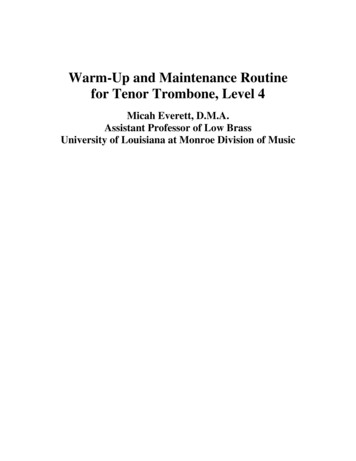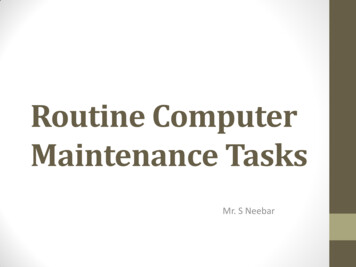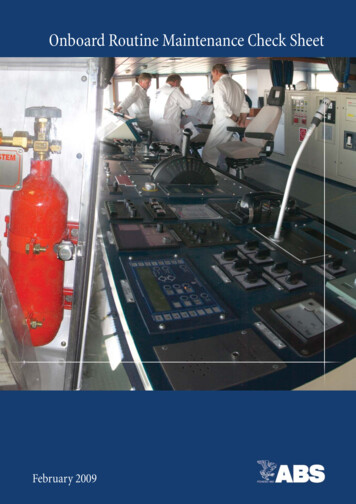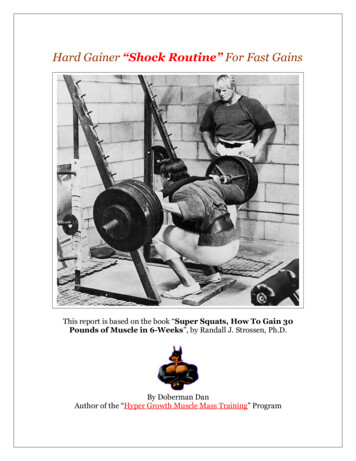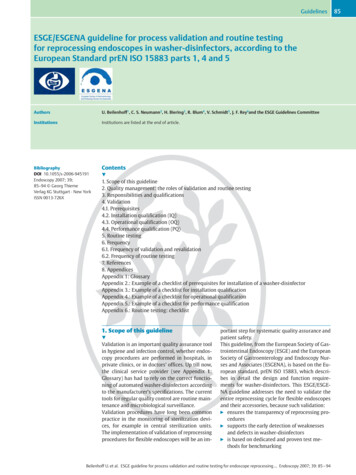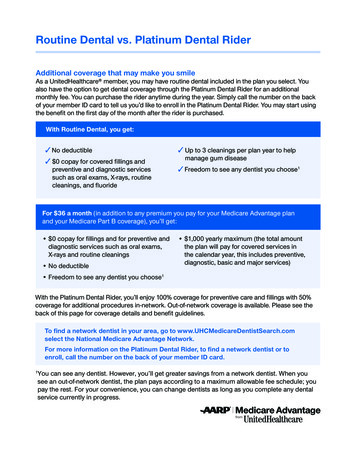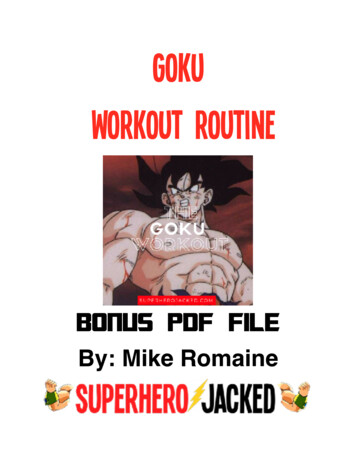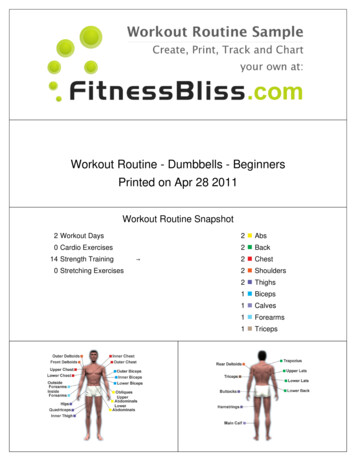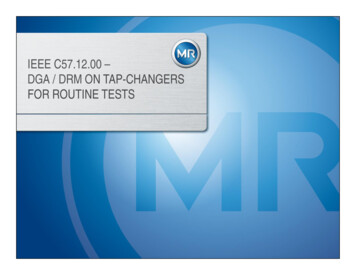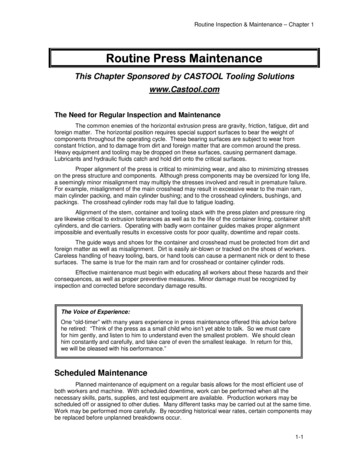
Transcription
Routine Inspection & Maintenance – Chapter 1Routine Press MaintenanceThis Chapter Sponsored by CASTOOL Tooling Solutionswww.Castool.comThe Need for Regular Inspection and MaintenanceThe common enemies of the horizontal extrusion press are gravity, friction, fatigue, dirt andforeign matter. The horizontal position requires special support surfaces to bear the weight ofcomponents throughout the operating cycle. These bearing surfaces are subject to wear fromconstant friction, and to damage from dirt and foreign matter that are common around the press.Heavy equipment and tooling may be dropped on these surfaces, causing permanent damage.Lubricants and hydraulic fluids catch and hold dirt onto the critical surfaces.Proper alignment of the press is critical to minimizing wear, and also to minimizing stresseson the press structure and components. Although press components may be oversized for long life,a seemingly minor misalignment may multiply the stresses involved and result in premature failure.For example, misalignment of the main crosshead may result in excessive wear to the main ram,main cylinder packing, and main cylinder bushing; and to the crosshead cylinders, bushings, andpackings. The crosshead cylinder rods may fail due to fatigue loading.Alignment of the stem, container and tooling stack with the press platen and pressure ringare likewise critical to extrusion tolerances as well as to the life of the container lining, container shiftcylinders, and die carriers. Operating with badly worn container guides makes proper alignmentimpossible and eventually results in excessive costs for poor quality, downtime and repair costs.The guide ways and shoes for the container and crosshead must be protected from dirt andforeign matter as well as misalignment. Dirt is easily air-blown or tracked on the shoes of workers.Careless handling of heavy tooling, bars, or hand tools can cause a permanent nick or dent to thesesurfaces. The same is true for the main ram and for crosshead or container cylinder rods.Effective maintenance must begin with educating all workers about these hazards and theirconsequences, as well as proper preventive measures. Minor damage must be recognized byinspection and corrected before secondary damage results.The Voice of Experience:One “old-timer” with many years experience in press maintenance offered this advice beforehe retired: “Think of the press as a small child who isn’t yet able to talk. So we must carefor him gently, and listen to him to understand even the smallest problem. We should cleanhim constantly and carefully, and take care of even the smallest leakage. In return for this,we will be pleased with his performance.”Scheduled MaintenancePlanned maintenance of equipment on a regular basis allows for the most efficient use ofboth workers and machine. With scheduled downtime, work can be performed when all thenecessary skills, parts, supplies, and test equipment are available. Production workers may bescheduled off or assigned to other duties. Many different tasks may be carried out at the same time.Work may be performed more carefully. By recording historical wear rates, certain components maybe replaced before unplanned breakdowns occur.1-1
Routine Inspection & Maintenance – Chapter 1Sponsor's advertisement -- more information www.castool.comBy contrast, “breakdown maintenance” must depend on the workers and skills available atthe moment of breakdown, and delays often occur while the appropriate people, repair parts, andsupplies are rounded up. Work is seldom performed well or efficiently, and many items that couldhave been done at the same time must be delayed until the next unplanned breakdown.Well-organized plants schedule press repairs on a regular frequency, usually taking “PM”(preventive maintenance) or “down-days” weekly or semi-weekly. Tasks are scheduled according toitems noted on daily inspections, plus items scheduled at a frequency determined from pastexperience. Monthly, quarterly, semi-annual, and annual PM periods will take longer according to theadditional checks included in the established schedules.It is not possible to set an overall “standard” frequency for preventive maintenance; it isdifferent for each press and for each company. Even though suggested maintenance intervals aregiven in Chapter A - Maintenance Schedules, these are indicative only and should be adjustedbased on your actual situation:1-2 the design of your equipment its age its actual history
Routine Inspection & Maintenance – Chapter 1 requirements of yourproduction scheduleThe frequencies suggested here are based onthe opinions of various equipment suppliers andexperienced extrusion plant engineers, andthey can be a good reference for establishingyour own schedules and program.Predictive MaintenancePredictive maintenance uses moderntechnology to determine a machine’s conditionwhile it is operating, records the information,and analyzes the recorded information topredict the optimum time and extent of repairneeded to keep the machine in its best1condition. Examples of PredictiveMaintenance of Extrusion Presses include: hydraulic oil analysis Magnetic Particle Inspection andUltrasonic Testing of presscomponents to detect fatiguecracks infrared scans of electricalequipment to look for overheating vibration monitoringFigure 1-1: Ultrasound test of main cylinder(Photo courtesy of Presezzi Extrusion)Figure 1-1: Ultrasound test of main cylinder(Photo courtesy of Presezzi Extrusion)Preventive MaintenancePreventive Maintenance (PM)Figure 1-2: Infrared view of an overheated fusedescribes any scheduled maintenance taskblockwhich is performed to prevent unplannedFigure 1-2: Infrared view of an overheated fusemaintenance or breakdown. PM usuallyinvolves routine, repetitive tasks, and may beperformed by maintenance people or operators.The list of PM tasks for any plant is constantlychanging, according to records of breakdown-causing problems as well as items found on otherPM’s.Included in Chapter A are suggested Maintenance Schedules for extrusion press plants.These can be used as the basis for establishing a PM program if one does not already exist. (Copiesof these schedule sheets are also included in Spreadsheet format on the CD version of this Manual.)Preventive Maintenance PlanningAfter the Preventive Maintenance program is in place, effective performance requiresplanning for each PM. This means devoting the time and manpower to analyze each task and itsfrequency; then identifying the personnel, tools, parts, supplies, and test equipment needed for eachtask; and, finally, assuring that all are available for the PM period. Without this kind of planning,some tasks will be left incomplete or skipped entirely, and the PM program will be a failure.Daily Walk-Around Inspection. There is no substitute for a daily operating check of the press, justas an airplane pilot or truck driver makes a routine “walk around” check of his equipment. Withoutstopping the press, an appropriately trained supervisor, maintenance person or operator should1Eidson, B., “Improving Equipment Effectiveness Through Total Productive Manufacturing,”Proceedings of 6th International Aluminum Extrusion Technology Seminar, (1996).1-3
Routine Inspection & Maintenance – Chapter 1check the press thoroughly, noting items which may safely observed while the press is operating.The items observed will then be scheduled for repair according to the urgency of the problems. Asuggested check list for this daily inspection is included in the Preventive Maintenance Schedule. Ingeneral: Look at the motions of the main moving parts: container, crosshead, die changer, butt shear. Aremovements generally smooth and parallel? Look at alignment on a discard butt (or special scribed-dummy-die butt): a quick inspection willindicate alignment and condition of the container. Look at the tooling carrier or die slide: wear or build-up which may result in premature wear willbe evident here. Is the die changer or carrier clean? Look at the container, ram stem, and fixed dummy block: signs of buildup, misalignment, bentram, or other problems will appear here. Look at the main ram and auxiliary cylinders: oil leaks or damage to rods or bushings may bespotted. Look over the hydraulic system: for leaks, vibration, low oil, excess heat, changes in oiltemperature, or change in oil condition; all are signs of trouble ahead. Look for changes: what’s different from yesterday, and why?Note: also see the check-sheet-based approach by David Turnipseed in The Voice ofExperience, page 1-8.Mechanical MaintenanceMain Cylinder and Packing. The main cylinder packing should be observed for oil leaks, inparticular for any sudden increase in leakage, which may indicate damage to the packing or mainram surface. Packing should be checked for embedded particles, which may score the surface ofthe main ram. When tightening the packing, the gland ring must be tightened evenly all around.Spacers made of keystock may be used to measure that it is being tightened uniformly.Periodically the main cylinder should be checked for possible excess wear to the maincylinder bushing, as follows: extend the main ram just far enough to accommodate a machinist’s levelon the ram surface (about 18”). At this point the main ram should be fully supported by the main rambearing bushing. The main ram should be level to the same tolerance as the main cylinder: 0.0005in/ft (0.04 mm/meter). If the main cylinder’s platen surface is perpendicular and the ram is not level,the main ram bearing bushing is likely worn and may require replacement. The guide shoes of themoveable crosshead should just be touching the guide ways in this position.Main Ram. The main ram must be checked for nicks or scratches, which will damage packing andincrease oil leakage. If nicks or scratches occur, the surface must be immediately polished smoothwith a stone, then washed to remove the residue. Follow up carefully -- watch the area closely andrepack as soon as convenient, or immediately if scoring persists.Tie Rods. Check prestress of the tie-rods by feeling for clearance between the inside nuts andflanges while the press is under load. Any clearance, even 0.001 inch (0.025 mm) indicates loss ofprestress. Each nut should also be match-marked to the platen so that any rotation of the nut will beapparent.Follow the press manufacturer’s instructions for loosening nuts and adjusting the prestress oftie rods. In the absence of such manufacturer’s instructions, the following general procedure may beuseful:Prestressing of tie rods is usually accomplished by raising the press tonnage to 10% abovethe rating and using the main ram to stretch the rods, then tightening the inside nuts and lockingthem to retain the prestress.The inside nuts should remain tight, even under full load, and should not allow insertion ofeven a 0.001 inch feeler gauge (0.025 mm) between the nut and flange. Likewise when the load isrelaxed there must be no clearance between the platen and outside nuts. With sleeved tie-rods, no1-4
Routine Inspection & Maintenance – Chapter 1space is permitted between the sleeve and platen. Any such space indicates a loss of pre-stress andrequires re-torqueing of nuts and rechecking of squareness.Note also the recommended procedures for detecting, monitoring, and repairing cracked tierods, in Chapter 4 - Inspecting and Repairing Major Components.Front Platen. The condition of the front platen pressure ring is critical to die performance and soshould be checked often with straightedge and feeler gauge. The primary concerns are looseness,cracking, or distortion; for example “coining”, in which a permanent impression is made in the ring.Repair or replace the pressure ring if any damage is detected. The old ring may sometimes bereturned to a smooth and parallel condition by grinding and shimming.Crosshead, Guideways, and Guide Shoes. Correct adjustment of the crosshead is discussed inChapter 2- Press Alignment. In addition to alignment, the guide ways must be checked for nicks orother damage to the surfaces, for example damage due to dropped tooling. Another concern isbrass pick-up on the ways, indicating possible poor lubrication, or that the brass shoes are notmaking proper contact due to misalignment. Guide shoes should be removed and fully inspectedperiodically; replace or re-machine as needed. Many presses are fitted with wipers to remove dirtand foreign matter ahead of the shoes; check these wipers for proper alignment.Crosshead Cylinders. Check for excessive oil on the rods, which may indicate damage to packingor bushings. Check clearances around the rods (also when repacking) which may indicate excesswear of bushings. Check for nicks, bending, or other damage to rods, which may damage thepacking. Check for oil leaks at cylinder connections. Check that the attachment nuts to thecrosshead are tight, including while under load. Check for excess heat, which may indicate that oil isby-passing the piston head (cylinder rebuild needed); hold the crosshead against main cylinder at fullpressure and check for temperature rise.Ram Stem. In addition to the alignment checks indicated in Chapter 2 - Press Alignment, the ramstem should be checked often for signs of bending, cracks, or upset, due to its critical nature and tothe excessive stresses involved. Check its straightness with a straightedge. Check the pressureplate to which the stem is mounted for damage, deflection, or “coining”, using a straightedge andfeeler gauges; remove and re-grind flat if damaged. The seat must also be clean. The stemretention ring or other stem mounting devices must be properly tightened.Check the stem and fixed dummy block often for signs of build-up or excessive wear. Anycontact forces are transmitted back to the main cylinder and may result in premature wear of themain ram and bushings, and to the crosshead cylinders as well.Container Holder, Guides, and Guide Shoes. C
Planned maintenance of equipment on a regular basis allows for the most efficient use of both workers and machine. With scheduled downtime, work can be performed when all the necessary skills, parts, supplies, and test equipment are available. Production workers may be scheduled off or assigned to other duties. Many different tasks may be carried out at the same time. Work may be performed .
